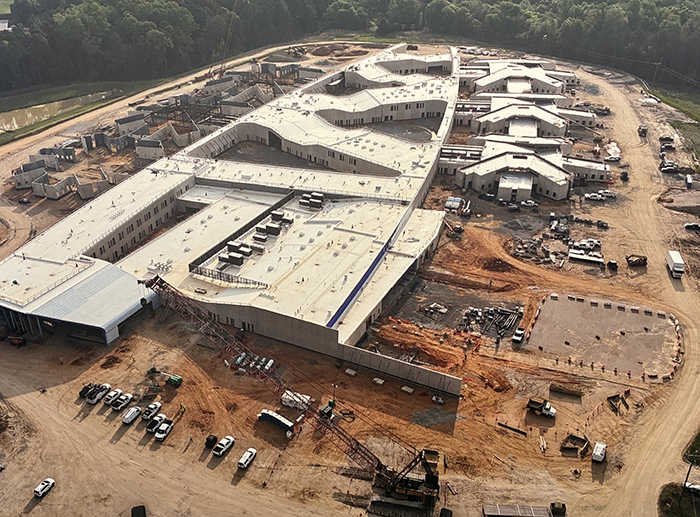After years of delay, the final steel beam was placed atop a new Central State Hospital in Dinwiddie County on May 1st. Projected to open next year, the new facility symbolizes the dramatic change in how we treat people living with a serious mental illness. As Angela Harvell, Deputy Commissioner said at the topping off event: “The new hospital will foster healing, growth, and recovery. It will show that mental health care is not a last resort, but a first priority.”
Filled with natural light, the most modern design and green spaces, the buildings will, according to Sen. Creigh Deeds, “show that we’ve come a long way.”
The site carries a complicated history. In recent years the current hospital faced severe overcrowding and dangerous staff shortages, as did other state hospitals, exacerbated by the pandemic to the point the Commissioner at the time closed hospitals to new patients. It is where Irvo Otieno died in 2023 during a controversial transfer by deputies from Henrico County Jail after a mental health crisis, bringing national attention and murder charges (later dismissed or withdrawn). It is also the place where overburdened but dedicated staff fought through pandemic conditions to keep very ill patients alive, providing selfless acts of kindness and courage.
Originally opened in 1870, Central State was the first psychiatric hospital in the country dedicated to the treatment of African Americans. A former Confederate facility, the “Central Lunatic Asylum” treated only African Americans until the passage of the Civil Rights Act of 1964. In the 1950s it held 4,800 people, with a working farm and cattle. A graveyard is on the property.
Generations of Black residents from Dinwiddie and Petersburg worked in the hospital complex, and it has the most complete records of Black mental health patients anywhere in the world. This history is the subject of a documentary film and an ongoing volunteer effort to preserve and understand this part of Virginia’s history.
Mental Health Virginia traces some of its history to Central State as well. When founded in Richmond in 1937 as the “Virginia Society for Mental Hygiene,” the organization adopted as its first priority to abolish the state practice of involuntary sterilization of patients. The practice in Virginia’s mental hospitals at the time was wholesale sterilization of those “afflicted with hereditary forms of insanity that are recurrent, idiocy, imbecility, feeble-mindedness or epilepsy.” (Richmond Times Dispatch, 02/20/37)
A 1942 Times Dispatch editorial praised the Society and Dr. R. Finley Gayle, Jr., “a prime mover” of the group and a leader of the State Hospital Board. It added: “Several strikingly able young psychiatrists have in recent years been attracted to the State hospital system, because of the opportunity it now affords to do work that will count. All of them are taking a part in the work of the Virginia Mental Hygiene Society, which deserves a major share of credit for what Virginia is doing in mental medicine.”
In the 1950s Mental Health Virginia, known then as Virginia Mental Health Association, affiliated with the national Mental Health Association (now Mental Health America), which adopted as its symbol the Mental Health Bell in 1953. The bell was formed by collecting chains and shackles from mental asylums around the country (including Virginia), melting them down at the McShane Bell Foundry in Baltimore, and casting the 300 pound Bell of Hope. The bell’s inscription reads: “Cast from shackles…, this bell shall ring out hope …and victory over mental illness.
At the recent construction celebration for the new hospital, Commissioner Nelson Smith said the new facility will symbolize that “Hope is real.”
We have come a long way. But the success of state hospitals, no matter how well designed, depends on individuals having access to a range of non-hospital supports in their community. Hospitals are an essential, but small part of a state wide system that provides prevention, treatment and recovery services to help keep people from needing hospitalization. In most cases, shorter term treatment is better done in a community setting.
Fortunately, leaders have also taken steps to develop the community facilities and services necessary to provide care in less restrictive environments, and closer to home. Like the new hospital, the process is taking too long, but without this fully funded and staffed care in our local communities, mental health crises will continue to overburden hospitals, and undermine their mission of longer-term care.
Let us celebrate the new Central State Hospital. And regardless of where treatment occurs, as Del. Mike Cherry said: “Let us continue to treat every person seeking help with dignity and respect.”




